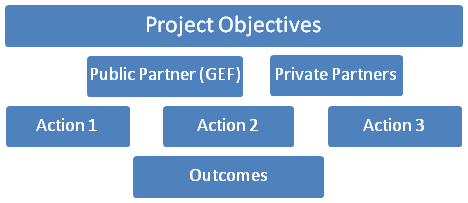5.1 - Partnership Analysis Tool
This partnership analysis tool will assist GEF project managers in:
1) Evaluating the purposes of the possible partnership and whether to enter into a partnership
2) Monitoring ongoing success.
The following questions will help outline and increase understanding of the partnership purpose:
- What are the water delivery problems or other environmental challenges that this partnership addresses? The project must first address key transboundary environmental challenges which the partnership should support.
- Who are the public entities in this project? What are their missions? The GEF, implementing agencies and GEF focal points for key ministries in the beneficiary countries and their missions must be identified. What would be the public organization that would serve as the primary partner?
- Who are the private entities? What are their missions? The partnership must be in the interest of the private sector companies and other organizations and their associated missions.
- What is the target population or beneficiaries of this project? What will be its impact on stress reduction?
- What are the business relevant actions and outcomes?
- What are the services that the public and private entities will provide? How are they different? How do they complement one another?
- What are the key implementation activities to be undertaken?
- How will the partnership improve impact? How will it help meet project and GEF IW goals?
- What are the strengths and weaknesses of the partnership?
- What are costs of the partnership? Is there a need for subsidization? Does the partnership make activities more affordable for partners and beneficiaries?
- Is the partnership sustainable or will it continue to need donor assistance? How?
- Is the partnership scalable and what are any barriers to scaling up?
Partnership Map
The following chart illustrates the work flow for potential public-private partnerships and how the partnership will leverage/share actions to yield increased outcomes:

- Step 1: Identify the project objectives and/or value proposition.
- Step 2: Identify the public and private partners and their roles.
- Step 3: Identify the key actions each partner will take to meet the objectives.
- Step 4: Identify the key project outcomes and how the partnership will increase the value to the beneficiaries and the GEF.
Once the answers are determined, the map should be adjusted to provide a tracking tool for the partnership.
The following are key questions in identifying a good partner:[2]
-
What companies in your country use water as an input in their production or other business activities? Are any of these industries experiencing (or likely to experience) water-related challenges in their productive operations or in their community relations? Answer: Consider both local companies as well as multinationals with a local presence.
- Which companies are selling water-related products or technologies in the local marketplace? Answer: Organizations should include pumps, piping, purification equipment, personal hygiene products, etc.
- Which companies’ activities have the most potential adverse impact on water quality or quantity in your country? Would any of these companies or industries welcome collaboration in improving their environmental performance or in meeting regulatory requirements related to water resource use, wastewater management or extraction of aquatic resources? Answer: Industry associations such as the American Water Works Association or Water and Wastewater Equipment Manufacturers Association may be a good place to start.
- What philanthropic organizations or foundations are active locally? Are any of them working in any aspect of the water sector? Answer: For instance, the Foundation Center has recently launched a water, sanitation and hygiene funders’ portal in cooperation with the Conrad Hilton Foundation. (http://foundationcenter.org/gainknowledge/research/pdf/washfunders_brief_2012.pdf)
- Are there any research or educational institutions that have a particular niche in some aspect of the water sector? Answer: The Consortium for the Advancement of Hydrologic Science offers connection to graduate programs, grants and research outcomes. (http://www.cuahsi.org)
- Are banks or financing institutions active in lending for any water-related services or technologies, including those associated with water for agriculture or industry? Would these institutions be potentially interested in collaborating with a GEF IW project and other partners in the water sector? Answer: An example of a recent public-private partnership on water is the $900 million financing package for the Atotonilco wastewater treatment plant in Mexico – the biggest facility of its kind in the world, with a maximum design capacity of 4.3 million m3/d. Private sector equity holders in the project company include Acciona Agua, Atlatec, IDEAL and ICA. Mexican national development bank Banobras provided a loan, while Fonadin, Mexico’s national infrastructure fund, put up a grant. The client is Conagua.
The questions and map above are competitive and transparent mechanisms to pursue opportunities that bring together the ideas, experience and skills of both sectors to develop innovative solutions to meet the GEF community’s needs, expectations and aspirations.
If you can answer the questions clearly and concisely, such a partnership is typically worth considering.
[1] The National Council for Public-Private Partnerships, 2003.
[2] USAID, 2009.

























